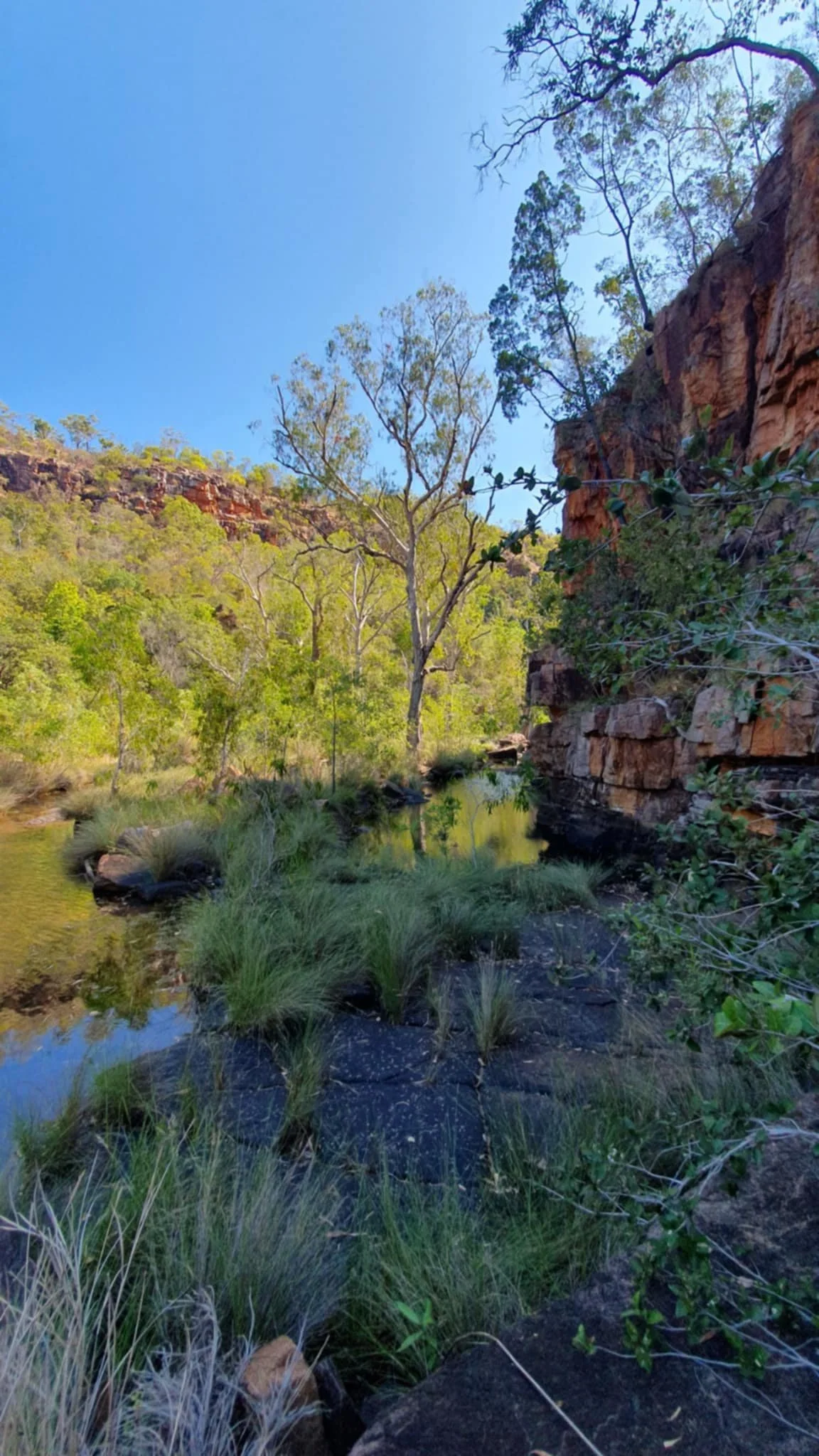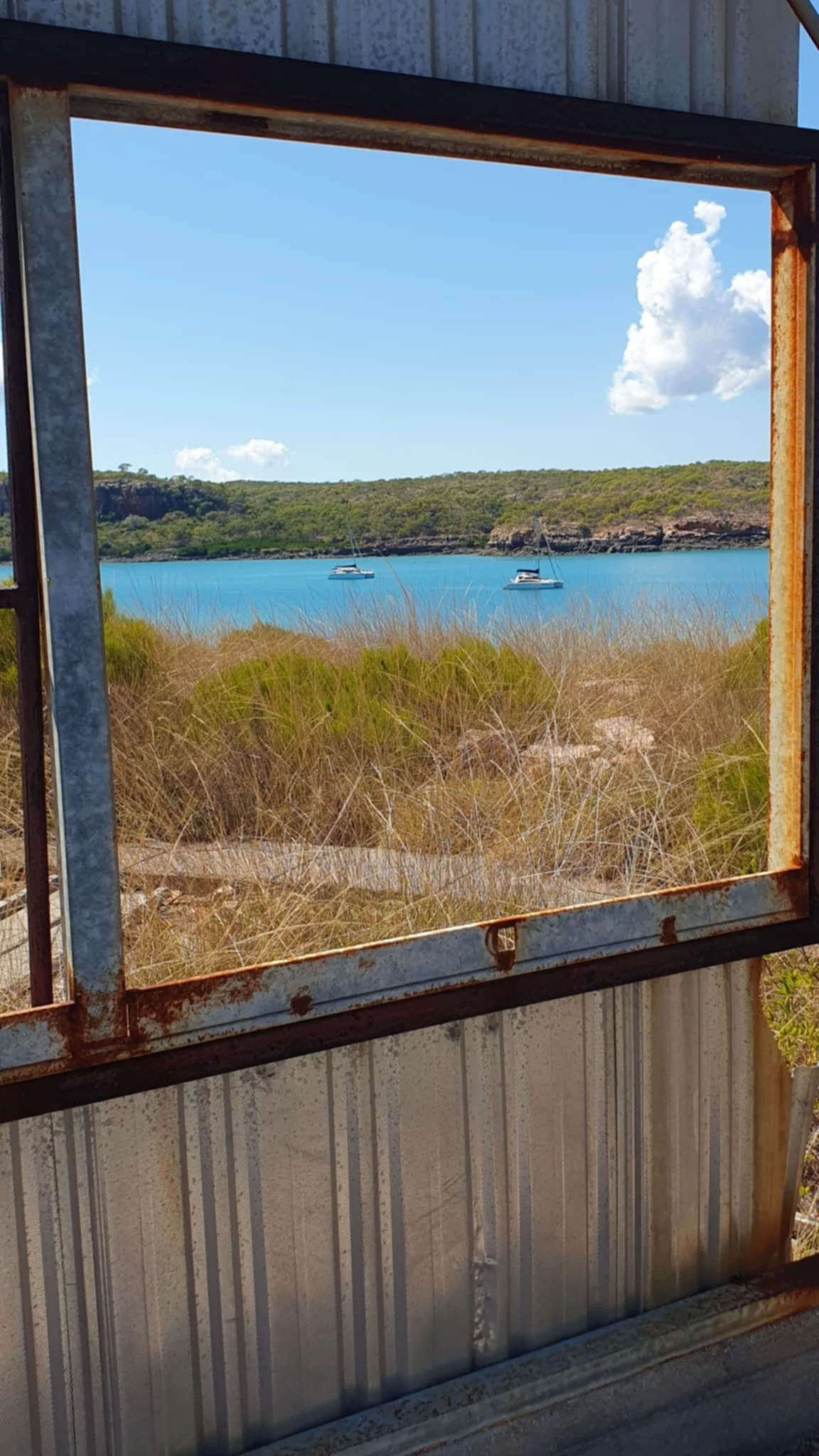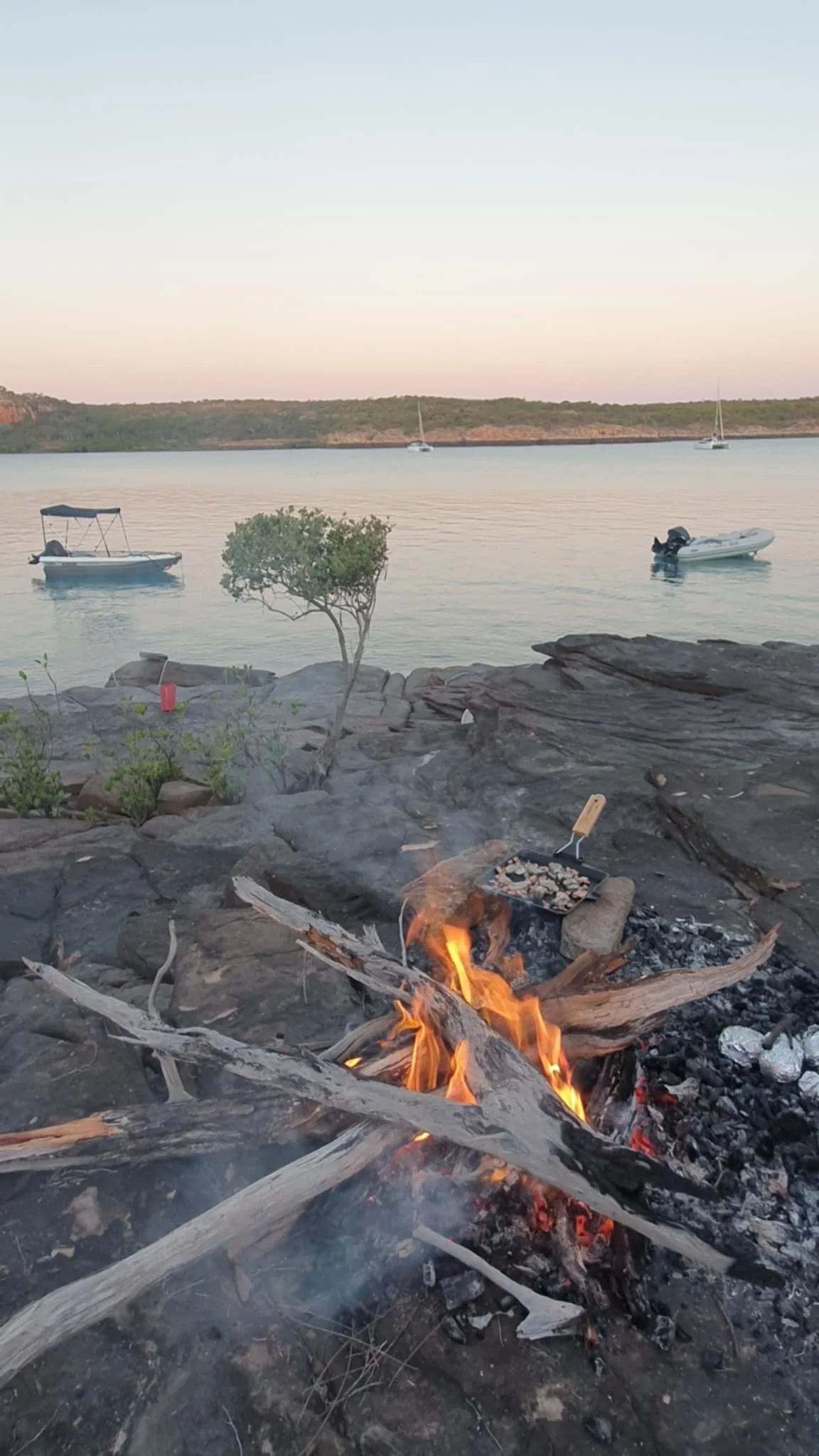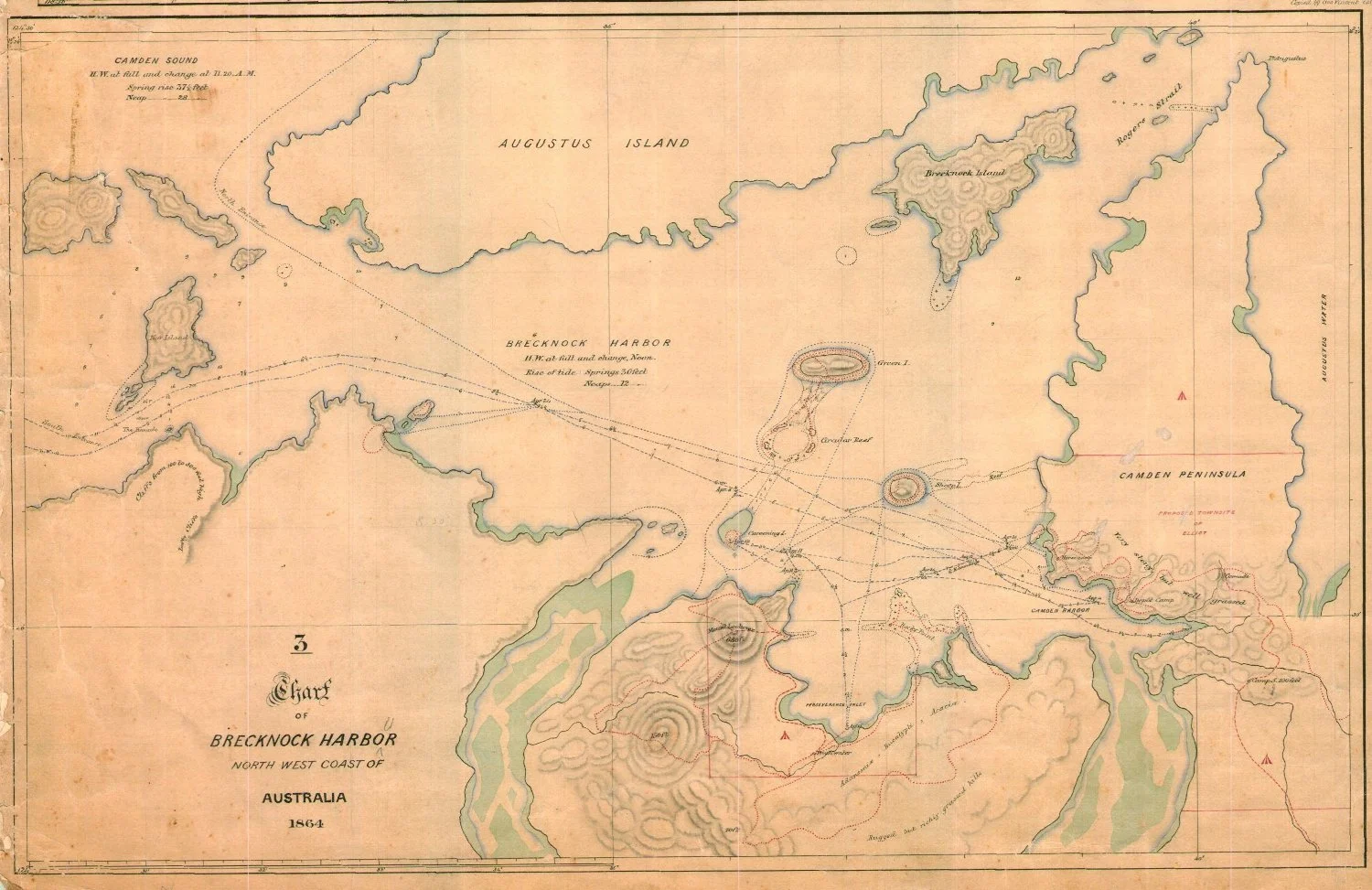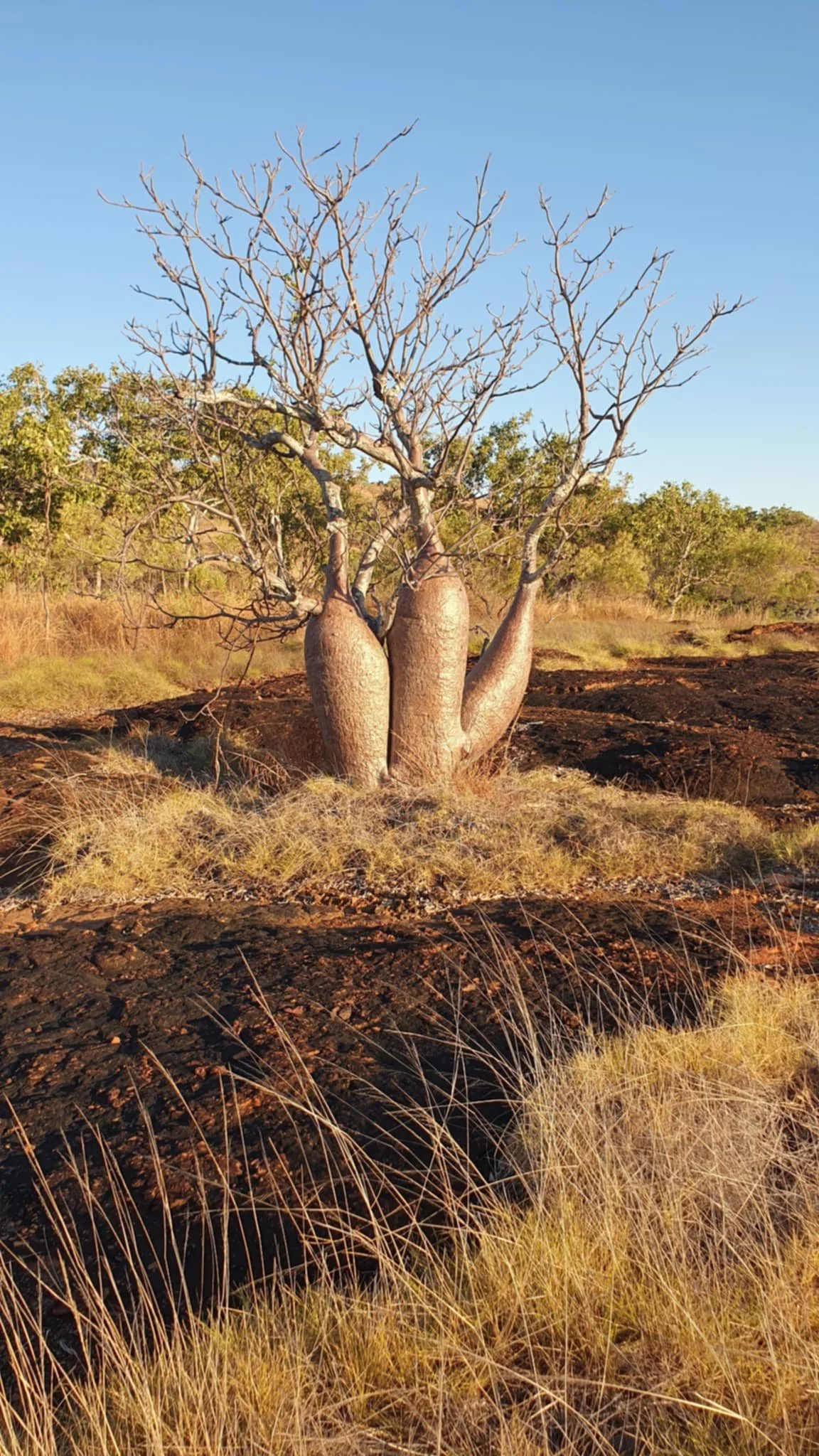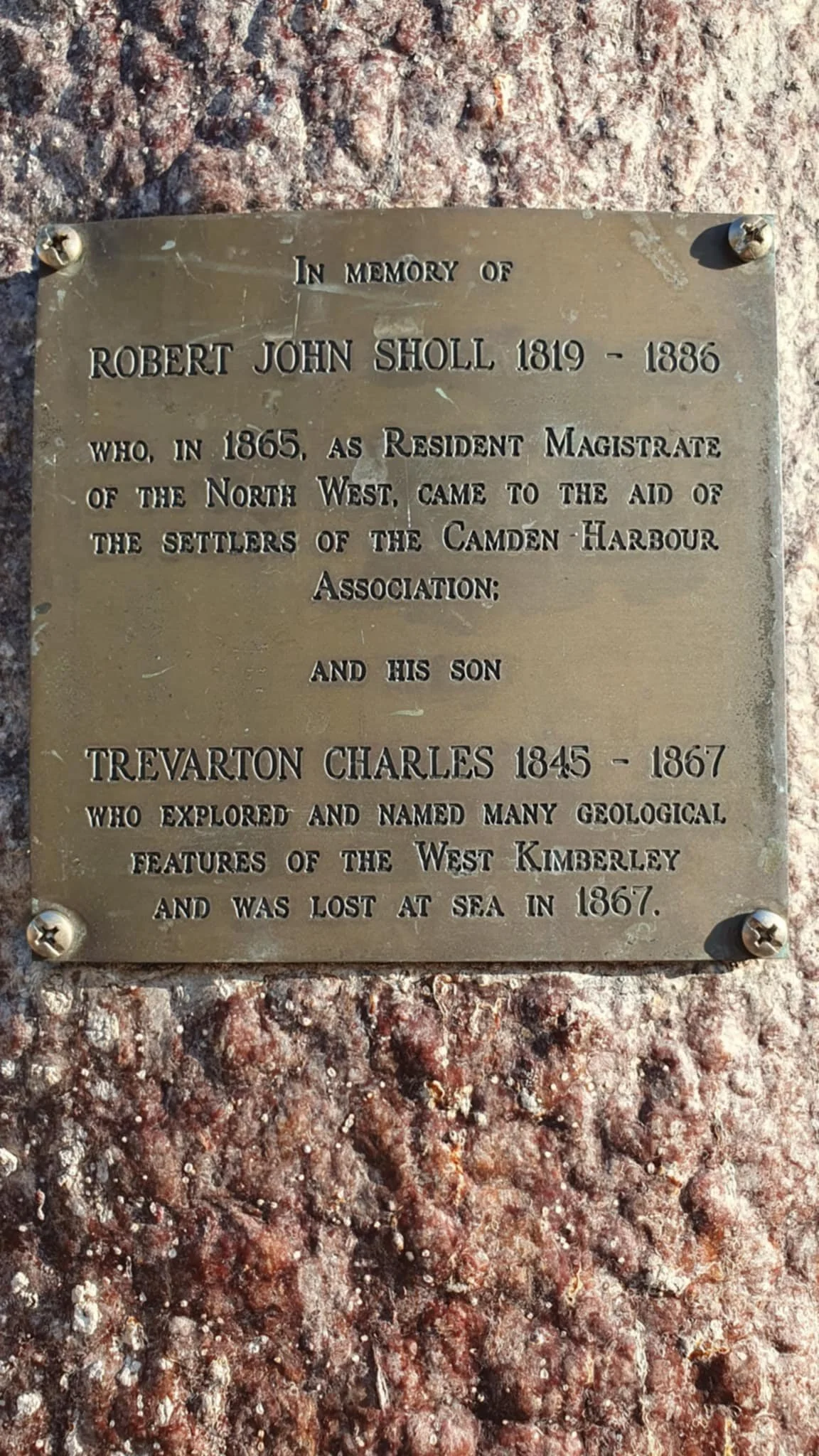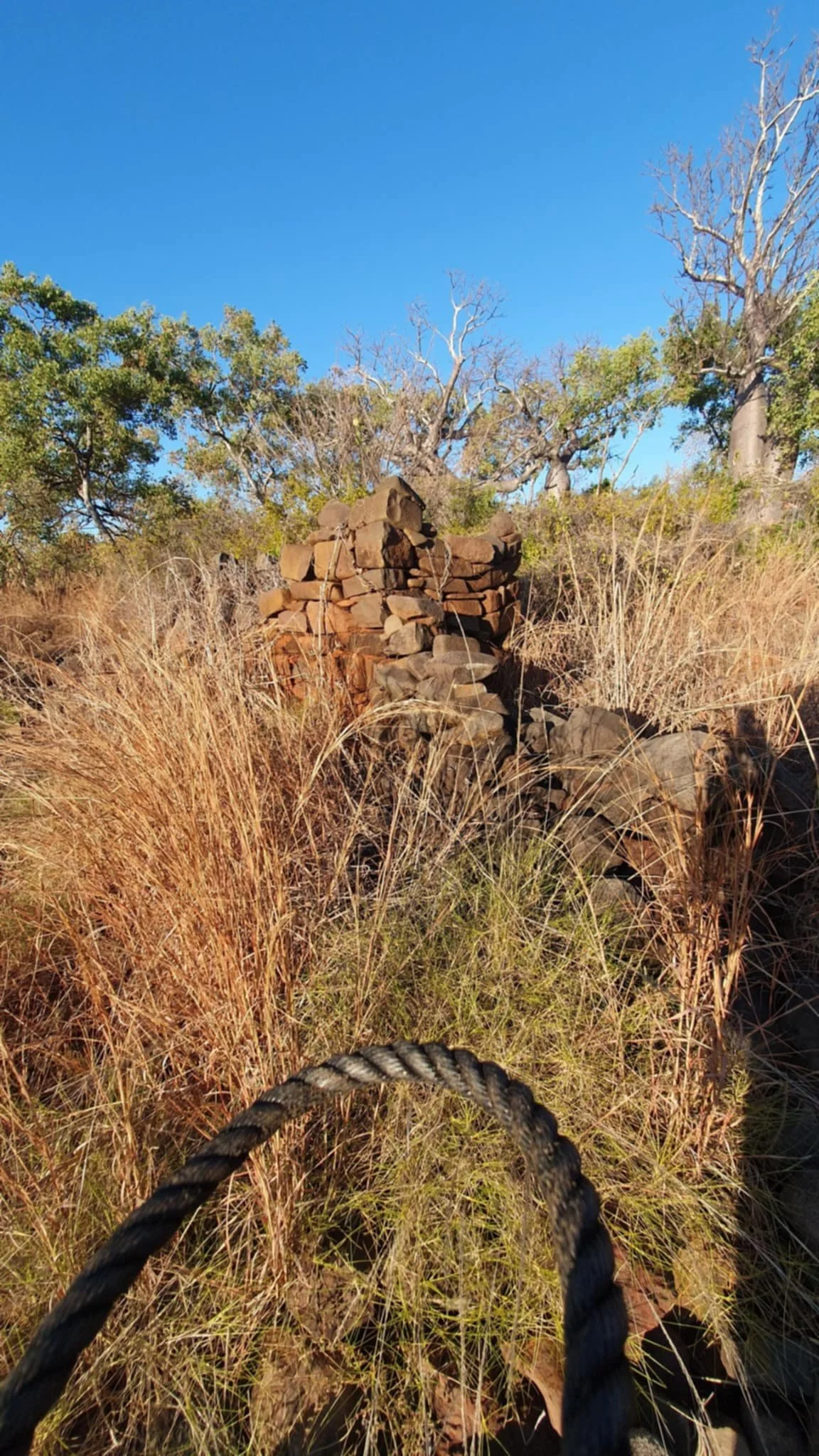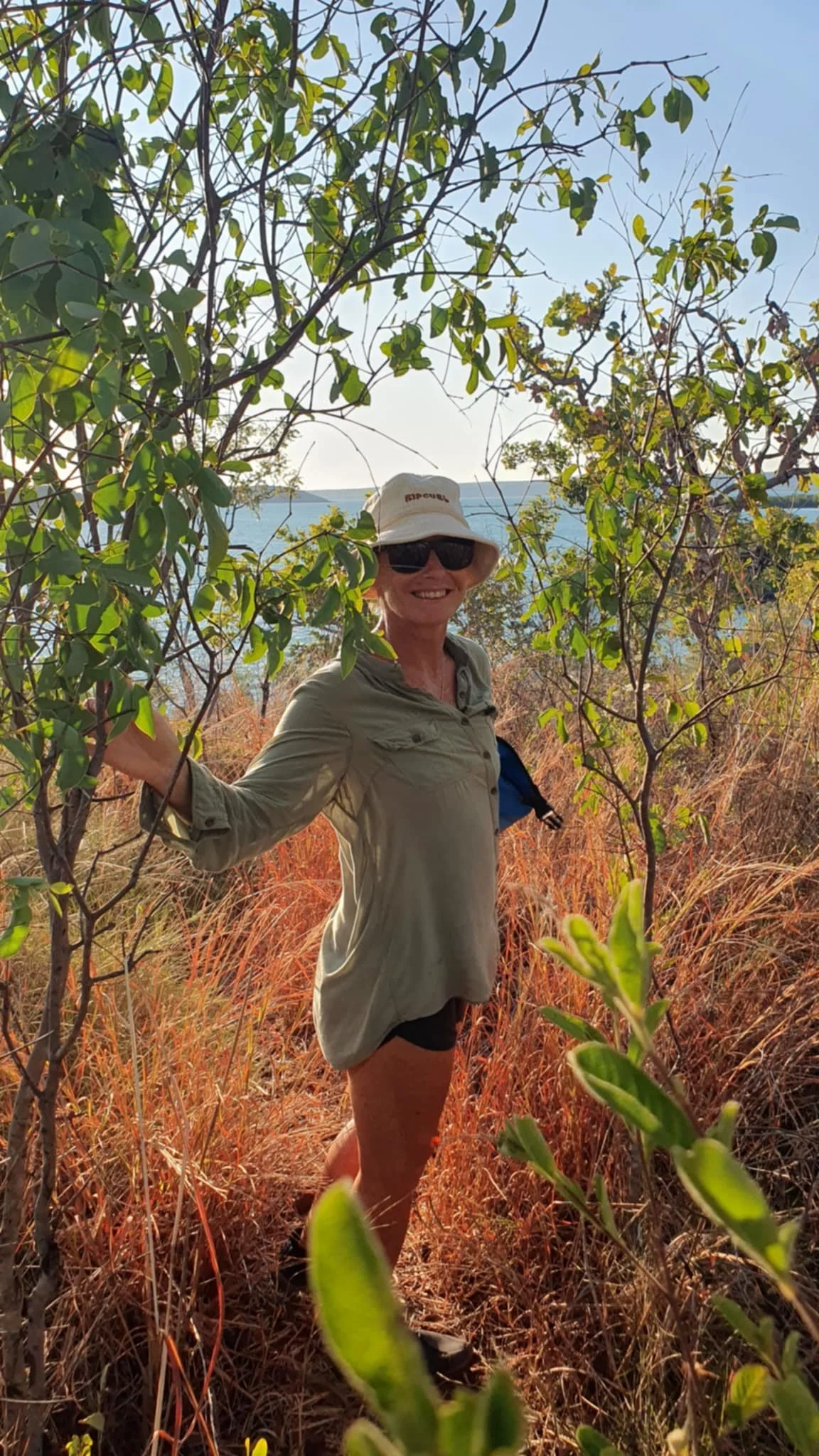History abounds in Camden Sound
Leaving Deception Bay on an outgoing tide, we were heading just around the corner to Sampson Inlet. A small protected harbour with reports of a good freshwater pool located up at one end was enough to entice us in for a few days exploring.
Sampson Inlet is used as a cyclone mooring area for Kuri Bay and they also moor up some of their unused infrastructure, which in this case was a large enclosed work place – aka a large donga on floats – which is probably a bit of a rudimentary description for what would be used to seed pearl shells etc.
Like Coppermine Creek, the inlet is surrounded by high wooded hills and filled with both birdsong and a lot of surface fish activity, something we haven’t generally seen in these types of inlets. Ted and Tina had picked up a tuna whilst entering and they seemed to be prolific in the inlet.
We anchored up in about 6 metres of water and Singularity was at the southern end of the anchorage, before the water shallowed out to just a few metres. Our plan was to settle for a while and then dinghy down to the head of the creek and try and find the freshwater swimming holes located right at the end of the inlet.
It was a beautiful dinghy ride down the inlet, with so much to see on both sides including boab trees, wooded escarpments, pockets of mangroves and lots of birdlife. We arrived at the end of the creek section to be greeted by a large section of rocks, which were yet to be covered by the tide. The decision was made to anchor up off the deep section and then walk around the edge of the mangroves and down into the watercourse and hopefully follow the trail to the water.
Once again a bit of a logistical exercise anchoring up the dinghies, keeping them far enough out to stay clear of rocks and mangroves as the tide rose, which involved running a pulley system off an anchor and then tying off to the nearest tree. The usual scramble across the rocks with backpacks and safety bag without hurting yourself; select a spot out of the tides reach to leave the safety bag and off we go!
It was a tough walk across rocks and along a small escarpment before then having to work our way through thick bush and spear grass up the watercourse. The first freshwater pool was found quickly but not deemed good enough or safe enough (too close to the salt and therefore the salties!) to swim. The signs were good as a canopy of trees provided shade and we started to push into pandanus palms and the birdsong increased.
Another ten minutes of rock hopping and we were treated to a great sight – a big swimming hole with a nice 15-foot waterfall flowing at one end. We were quickly in the water – boys first as the girls are usually too chicken so they wait for us to get eaten – if not then they come in for a swim too! A scramble up the waterfall revealed more pools and falls and a great few hours of freshwater wash before returning to our dinghies, which were safely still where we left them.
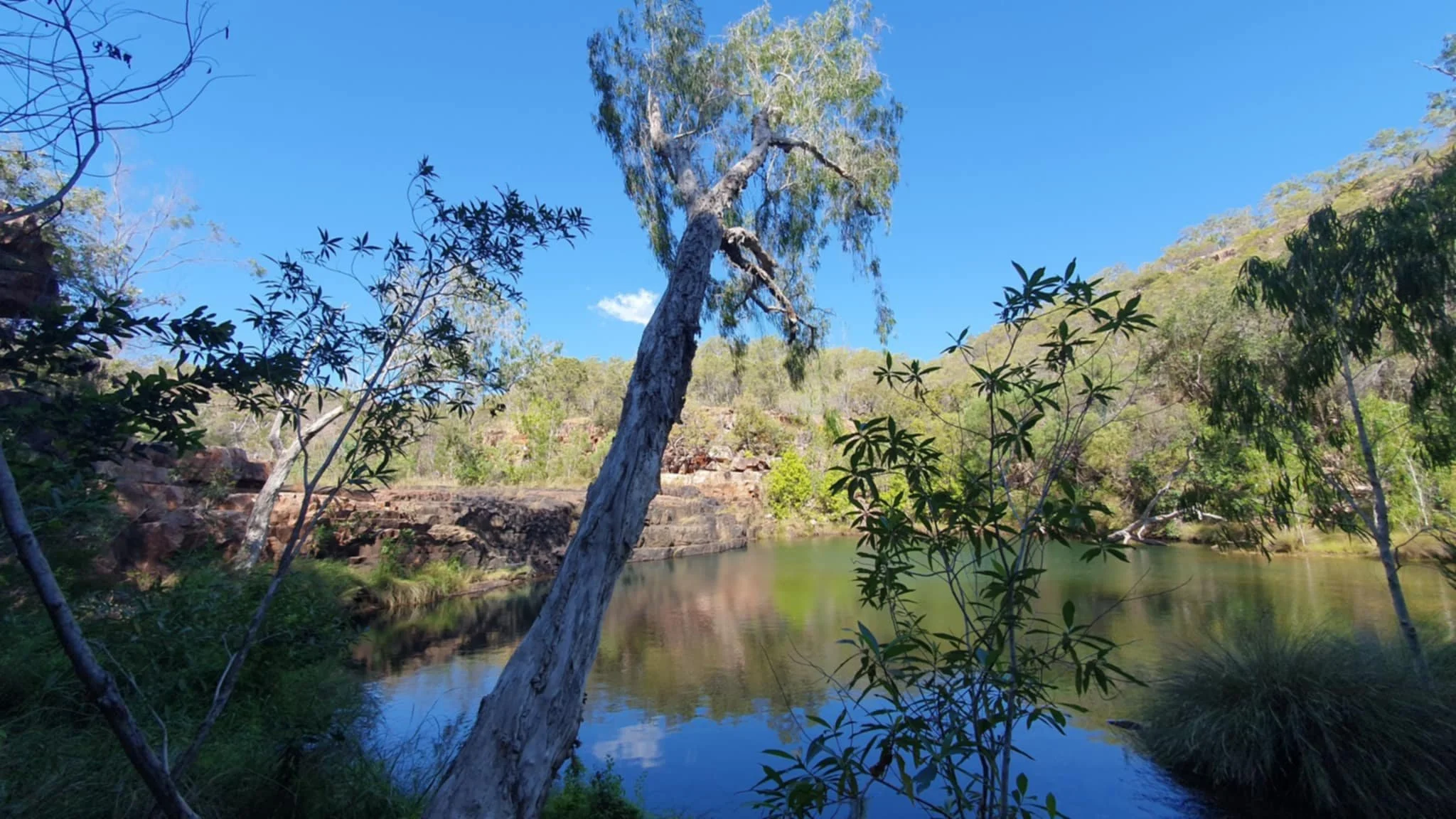
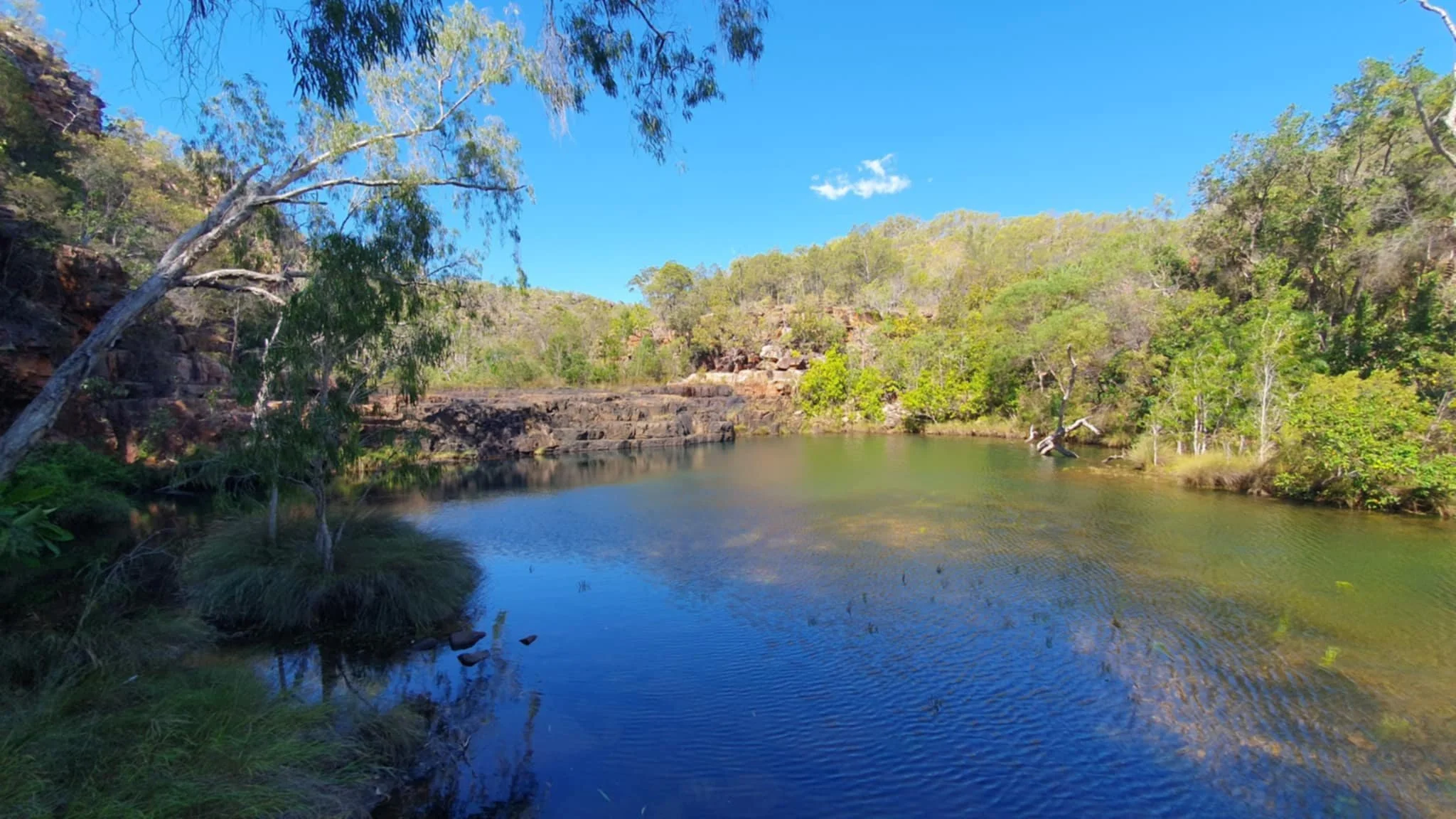
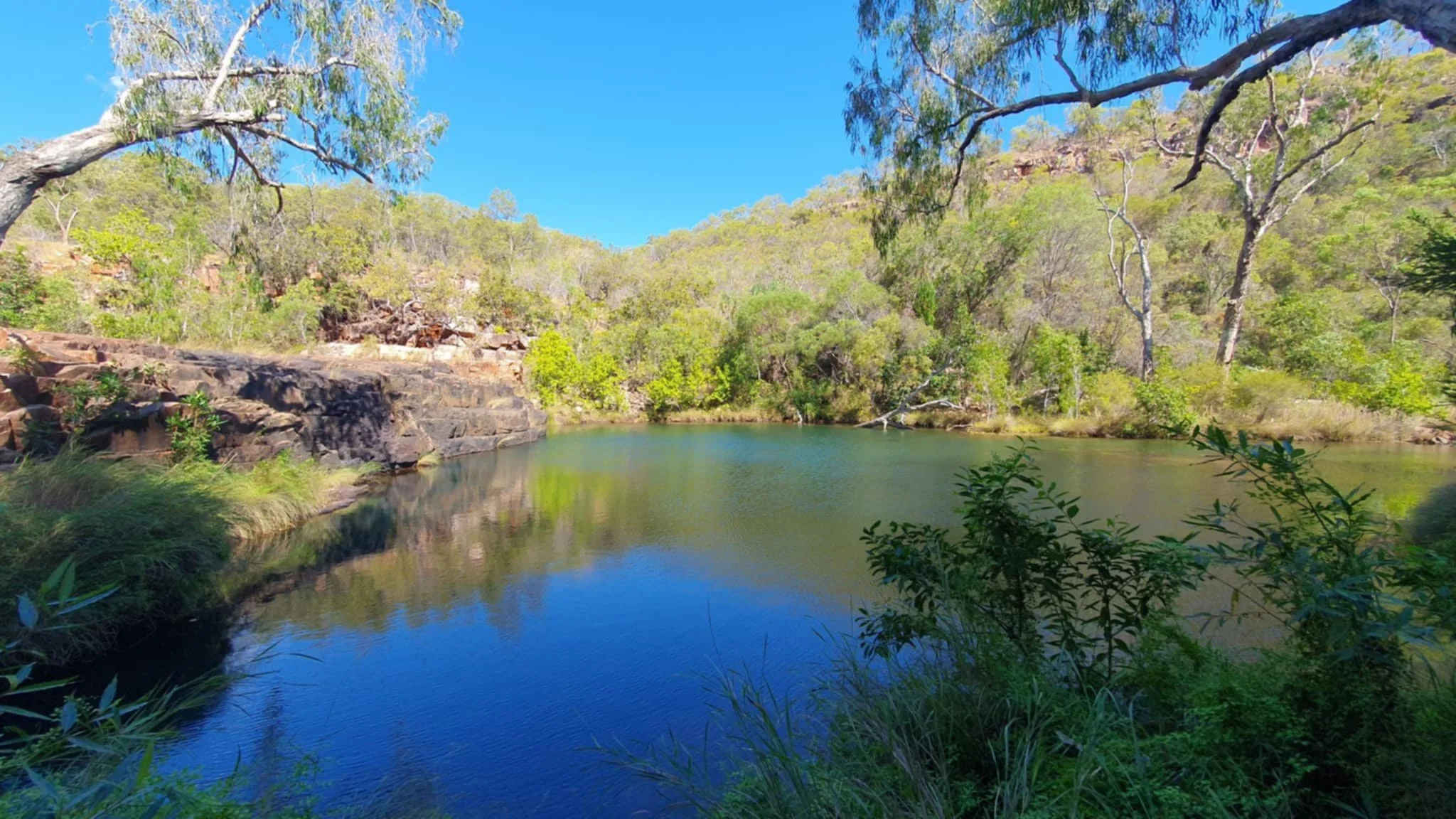





Our next destination was Hiro Bay, the sight of Paspaley’s original pearl farm back in the 70’s. We needed to wait for tide so we had a quick stop off at Wilson Bay for a bit of beachcombing before sailing the 11nm across to Hiro Bay, which is located on the bottom corner of Augustus Island. We were in Camden Sound now and this is the destination for all those whales swimming up the West Australian coast and so we were treated to breaching, pectoral fin slapping and general whale activities.
We arrived safely into Hiro Bay and set anchor just off the old camp and in a picturesque sheltered bay. It was late in the day so a quiet night with a day of exploring ahead of us tomorrow.
The temperatures were starting to heat up as we rose the next morning and took Bob into the small alcove where the camp is located. Quite a bit of infrastructure still remains, with the remnants of an old jetty plus a number of structures including an old accommodation building and the footings of the laundry/bathroom area. I do find it interesting that there doesn’t seem to be any desire to clean up the mess afterwards… perhaps they just think it is remote enough that no one will care?
After a good explore we set about finding some big juicy oysters on the rocks just below the camp and that afternoon we convened on the rock ledge and made a big fire. Oysters were shucked and washed down with some cold drinks, and we cooked up a few goodies in the campfire as well. An amazing setting with great company – super grateful to be having this experience!

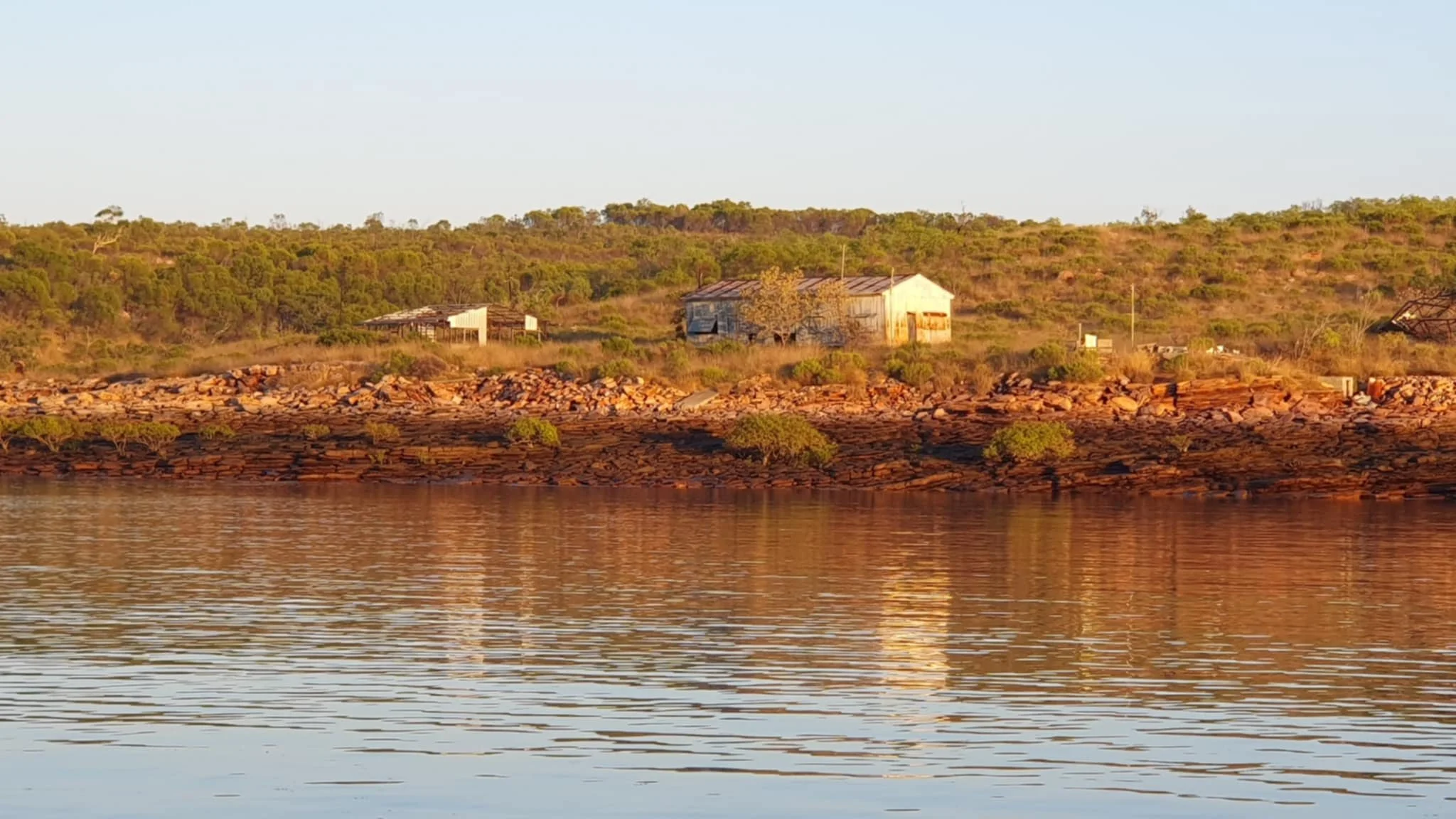



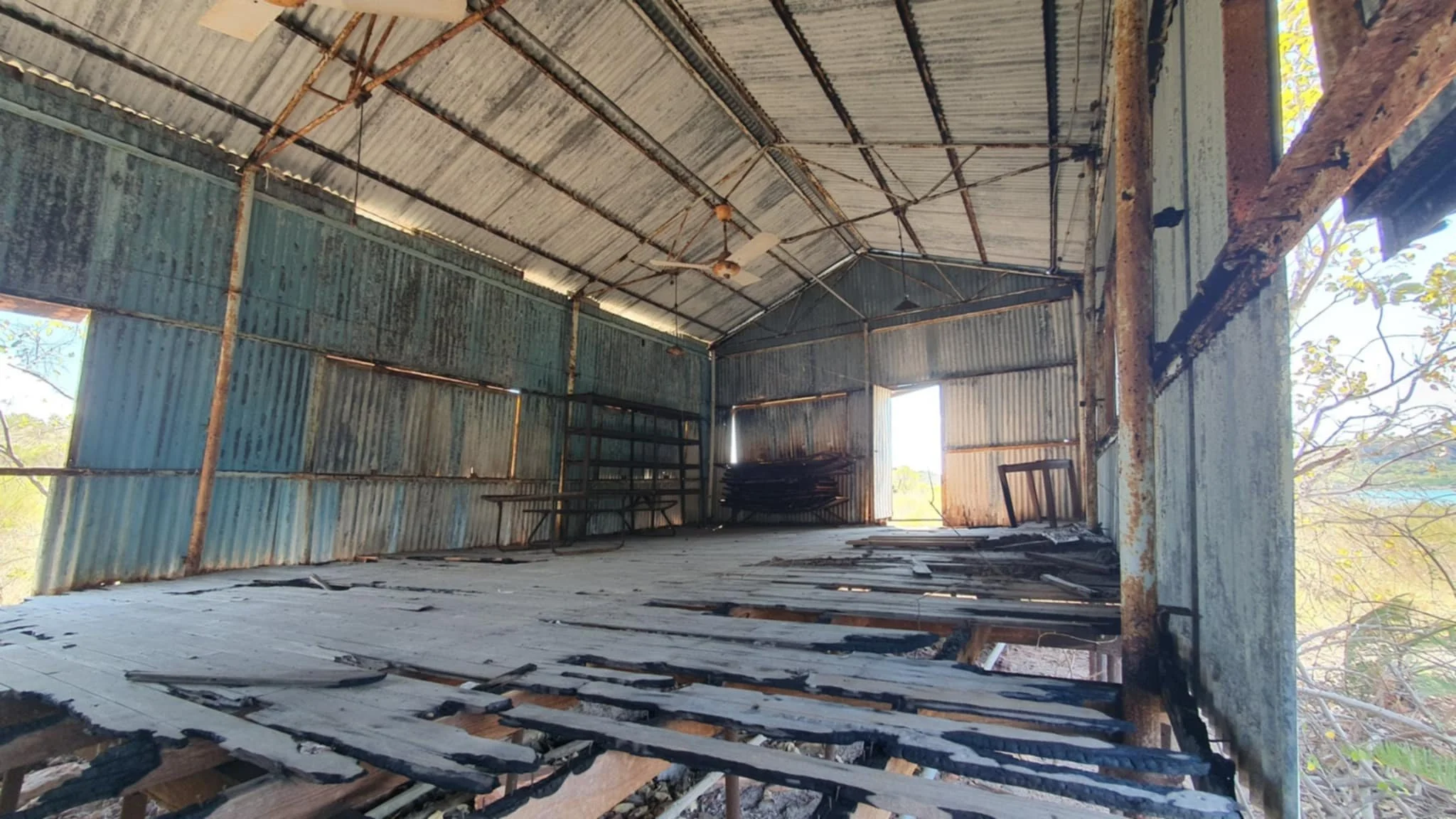
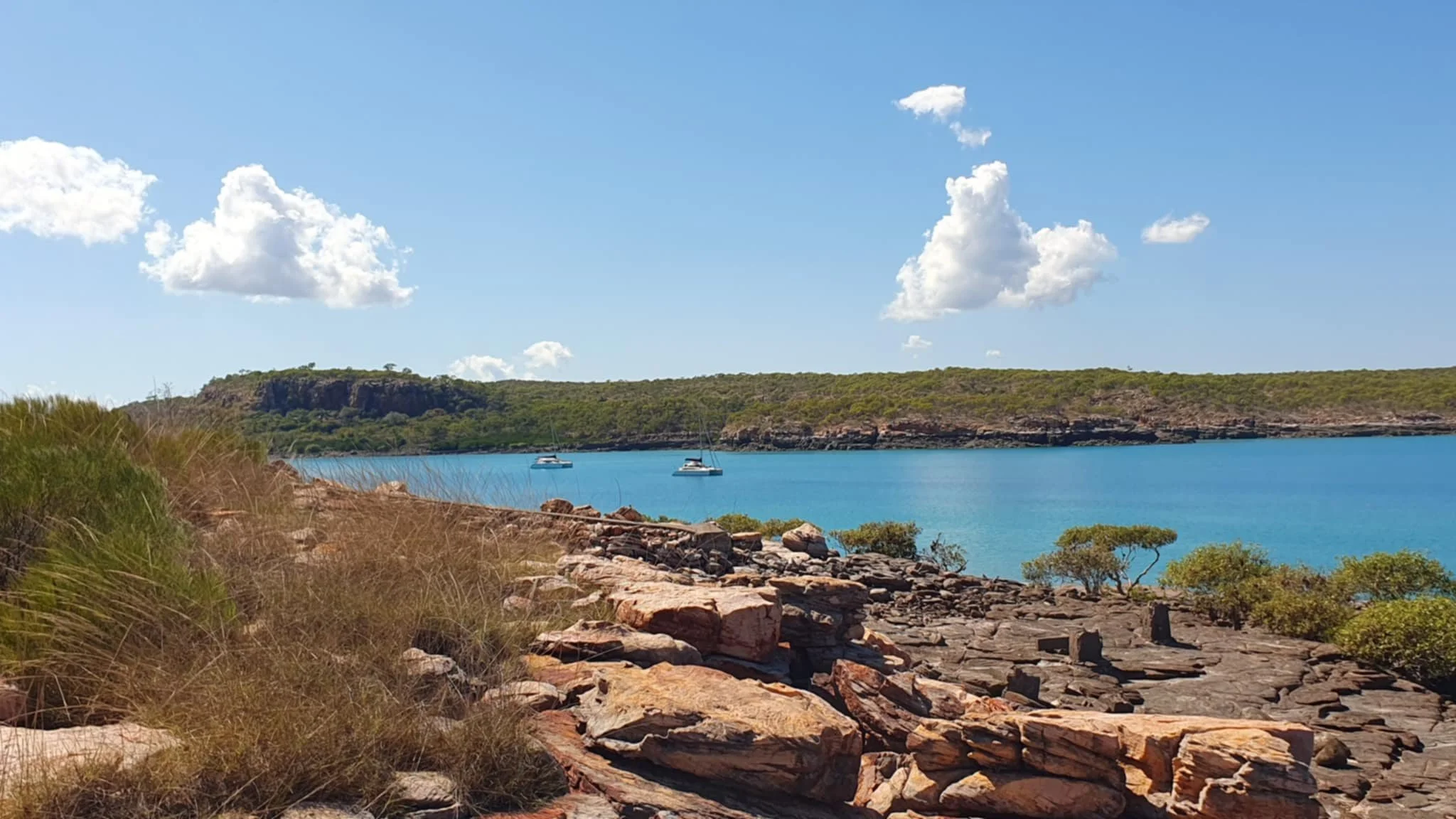







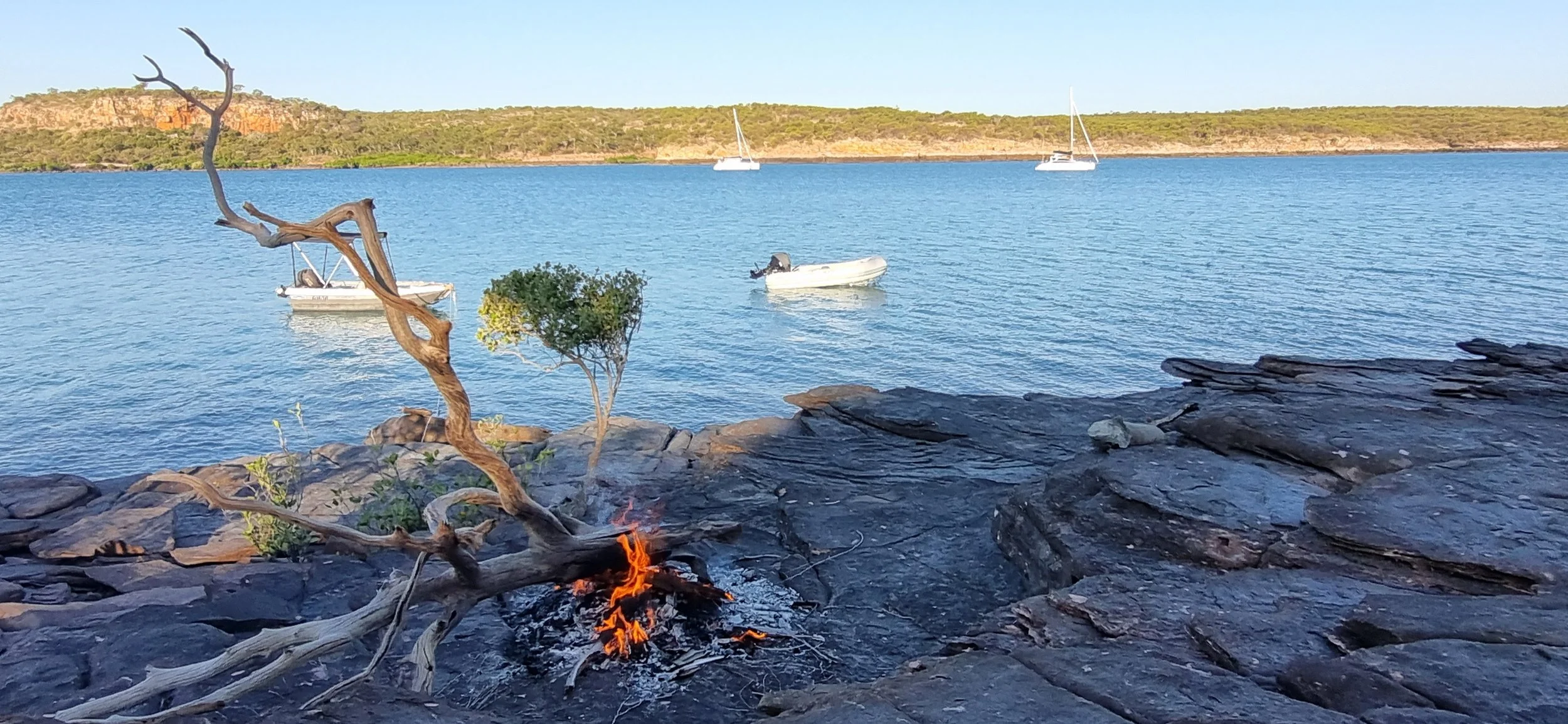
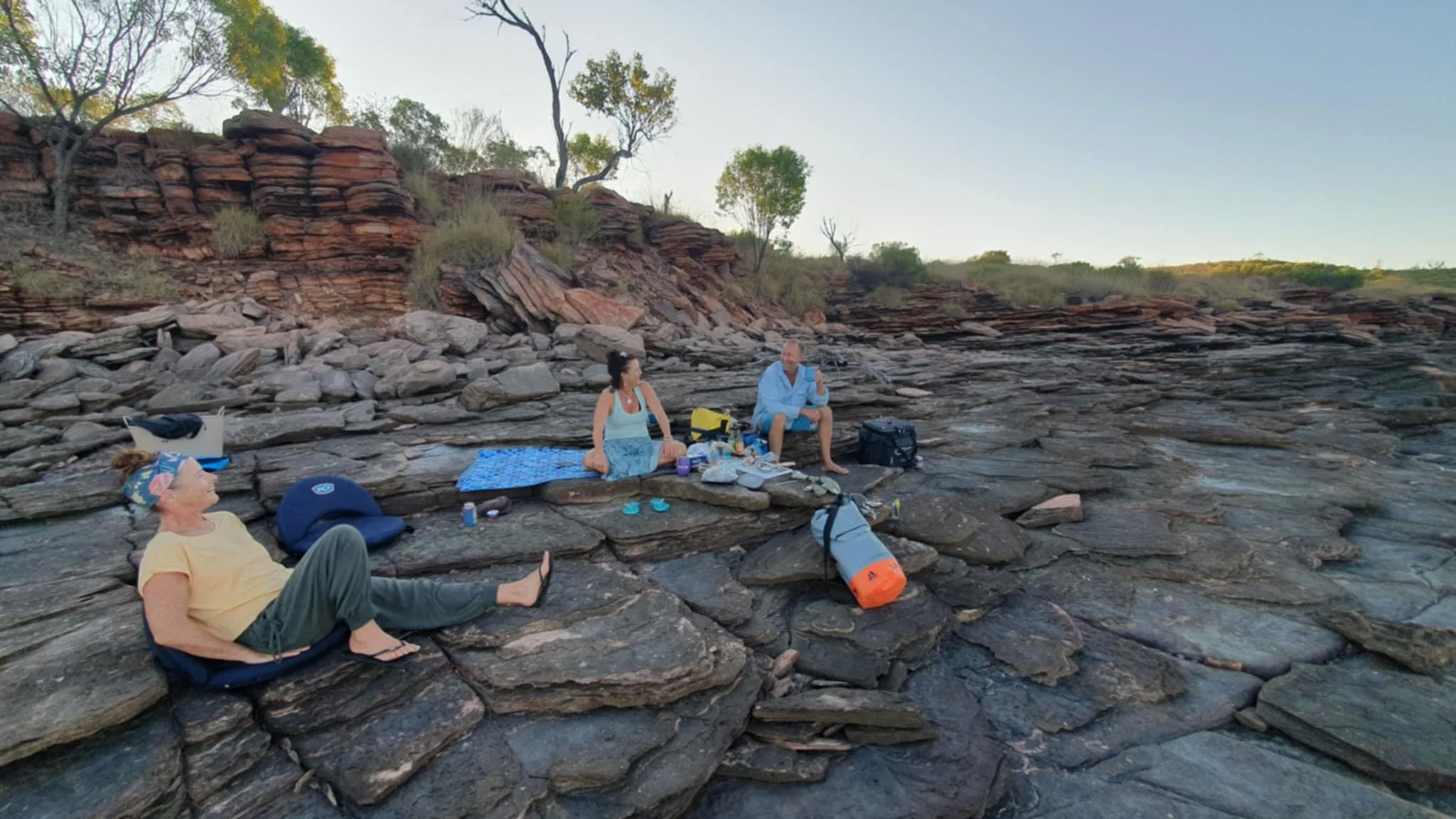


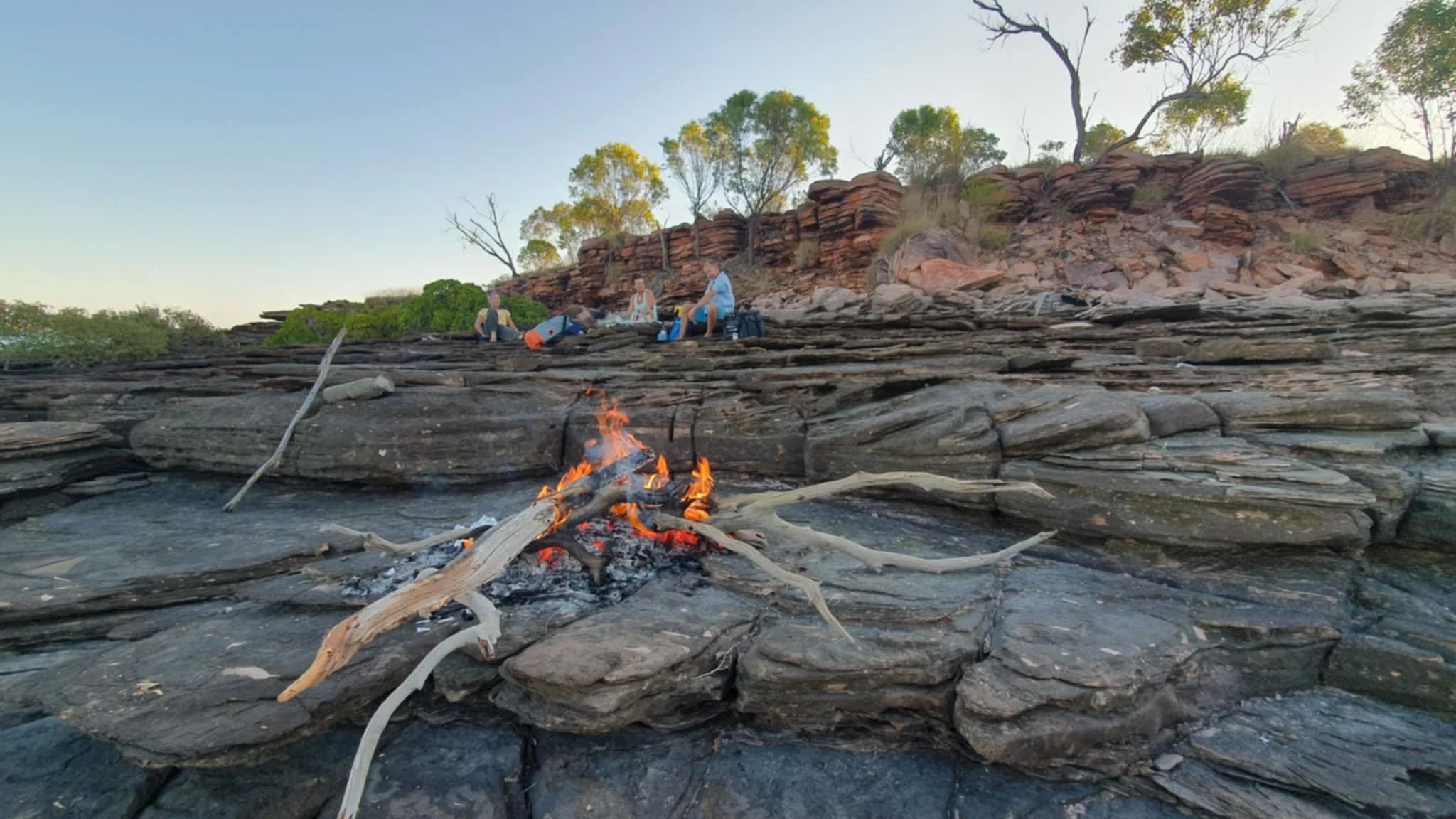
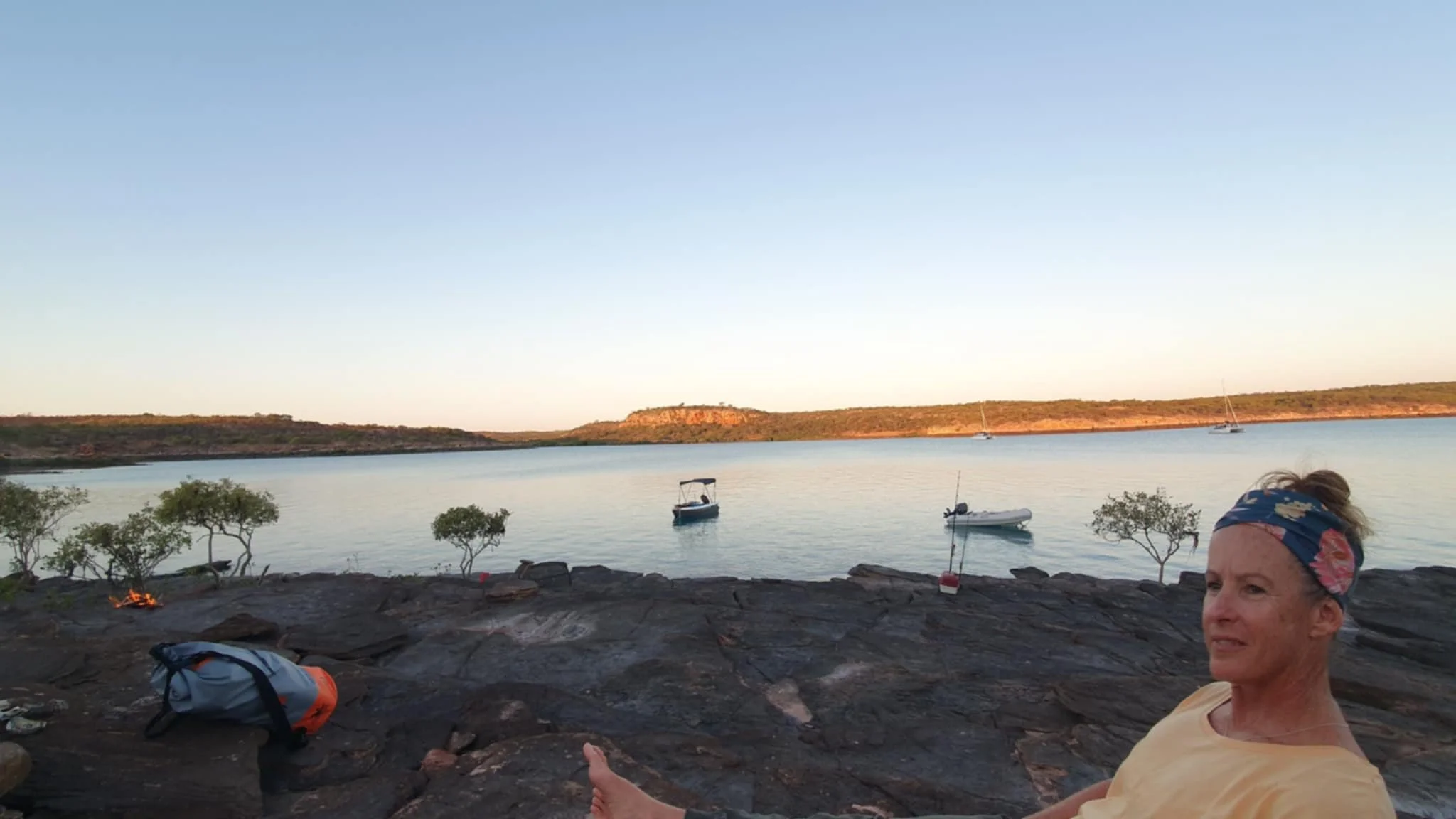




We sailed past Kuri Bay, famous for being at one end of the weather forecast (Wallal to Kuri Bay) and is now home to Paspaley Pearls Kimberley operations. It is a big set up with a lot of accommodation and also home to a very large pearl farm, but here in this bay and around the corner in George IV Sound.
Our destination was Sheep Island, a small islet located right down in the corner of Camden Harbour, a small area with a big history. We had two key points of exploration here, Sheep Island itself and then we intended to try and find the old Camden Harbour settlement.
Here is some history to put it all into perspective…
Three men are credited with the energy and forethought to spark the first attempt at European settlement in the western Kimberley at Camden Harbour. The W.A. Governor, John William Hampton, contributed men and money to a settlement scheme promoted by a slick Melbourne agent, William Harvey, based on glowing reports of Explorer George Grey. About 70 potential settlers, principally from the mining and pastoral areas around Ballarat and Bendigo, bought shares in the Camden Harbour Association and were assembled in Melbourne in late 1864. The settlers were about to sail to W.A. in ships, the "Stag", the "Helvetia" and the "Calliance".
After 3 weeks of sailing across the Great Australian Bight and up the W.A. coast, the "Calliance" struck hard on a reef near Adele Island. Unloading ballast, water and stockfeed lightened the ship. She drifted free and continued on to anchor in Camden Harbour on Xmas Day 1864. That evening one of the settlers died of sun stroke and was buried on Sheep Island. The "Stag" and "Helvetia" had arrived 12 days earlier, and some of the settlers already had their doubts about the viability of the venture.
While being brought close into Camden Head for careening, the "Calliance" was caught in a violent wet season storm and washed onto the rocks. As the tide dropped, the ship broke up on the rocks.
The W.A. Government sent a magistrate, a surgeon, policemen and surveyors to the settlement on the "Tien Tsin" from Perth in February 1865. When they arrived, the scene was one of utter chaos and misery. Such was the plight of settlers in the harsh Kimberley stormy wet season that many left on the "Stag" and the "Tien Tsin" with the skipper and crew of the ill-fated "Calliance".
The Government Camp was established outside the confines of Camden Harbour on the rocky slopes of the mainland directly east of Sheep Island. An access track was cleared through the rocks and mangroves to allow stores and building materials to be brought ashore, this track is still clearly visible today. There seems no doubt that the Government surveyor chose the best site for a camp; on a hill with cooling sea breezes and with a view out over Sheep Island and beyond to Brecknock Harbour, Green and Augustus Islands. The settlers struggled on for six months under intimidation by aborigines and lack of fresh water during the dry season. By October 1865, all of the sheep had died; the remaining few settlers, together with the government party and what few animals and possessions that could be carried away, abandoned the camps and returned south on the brig "Kestrel".
We nudged our way into the Sheep Island anchorage, which was quite shallow and were able to set our anchor only a few hundred metres off the island. With the afternoon coming on quickly, we were straight into the dinghy and onto the beach at Sheep Island. Located just up above the beach is a large boab tree, at the base of which is the grave of Mary Jane Pascoe, who was one of the last remaining females at the failed Camden Harbour settlement and was brave enough to remain with the hardy settlers. However, she became a victim of the harsh outback when she died on 4 June 1865 while giving birth to her child. It is noted that there are four or five other unmarked graves here and there was also a small memorial plaque for Police Officer Walter Gee, who was killed here whilst on duty back in 1865.
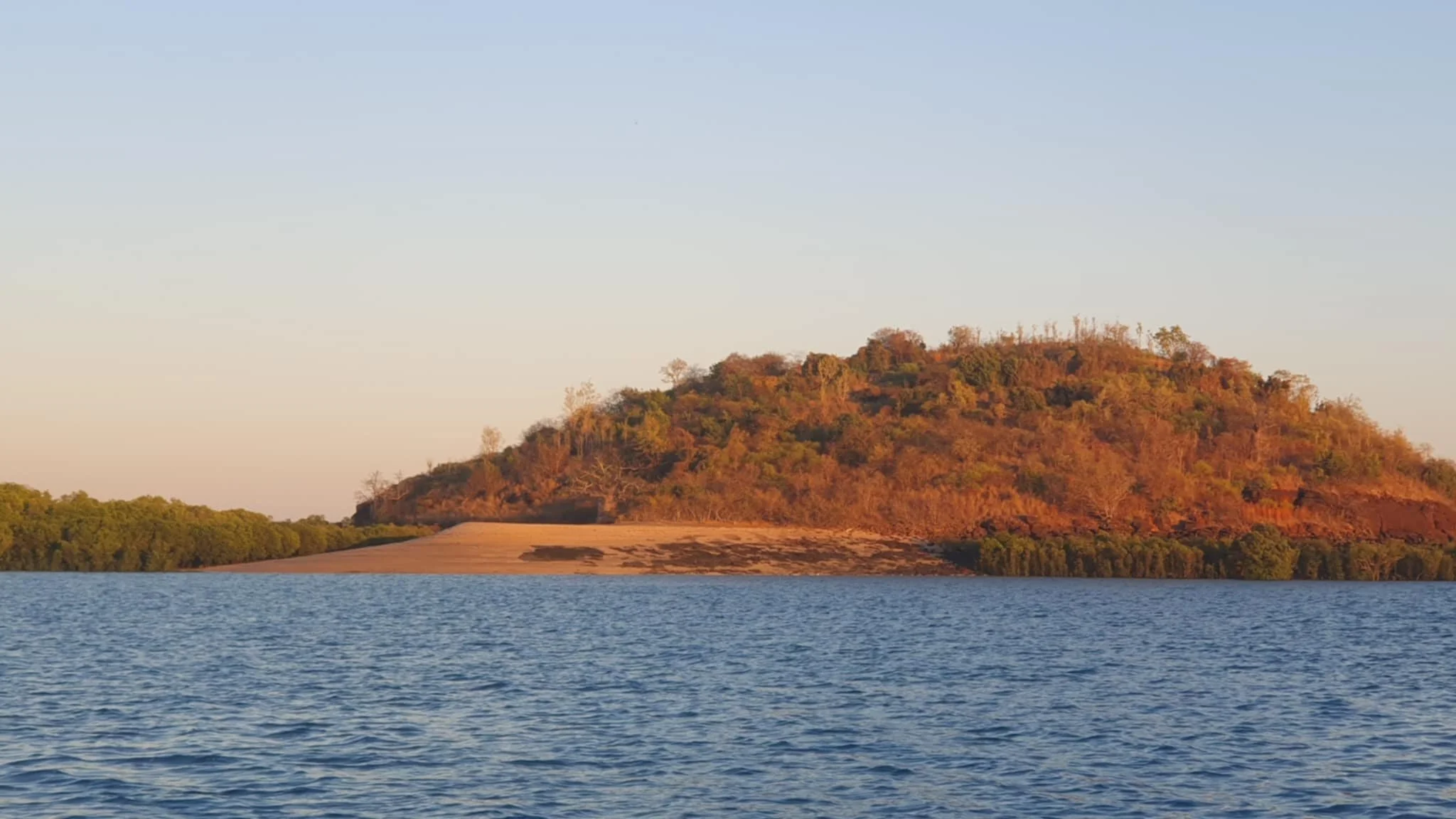


Gee was a member of Captain Scholl’s expedition to explore the northwest of Camden Harbour. Gee was speared in the shoulder when a group of Aborigines attacked the party which was travelling around the coast in a small boat. They escaped but were swept to shore about two miles from Camden Harbour where their boat overturned. Gee was rescued five days later but passed away shortly after. He was buried on Sheep Island. Quite a sobering reminder of how hard it must have been for these people who arrived from Melbourne, having been ‘sold’ the dream of a new start in a promising settlement.
Leaving Sheep Island, we headed across to the mainland to try and locate the old settlement. It took as a little while, involved some serious scrub bashing (picture overgrown with vines everywhere wrapping around you + hot + rocks!). Eventually we found the cleared area and some foundations of buildings/cooking areas and at the eastern end were a number of large boab trees, a couple of which had plaques paying tribute to some of the individuals at the settlement.

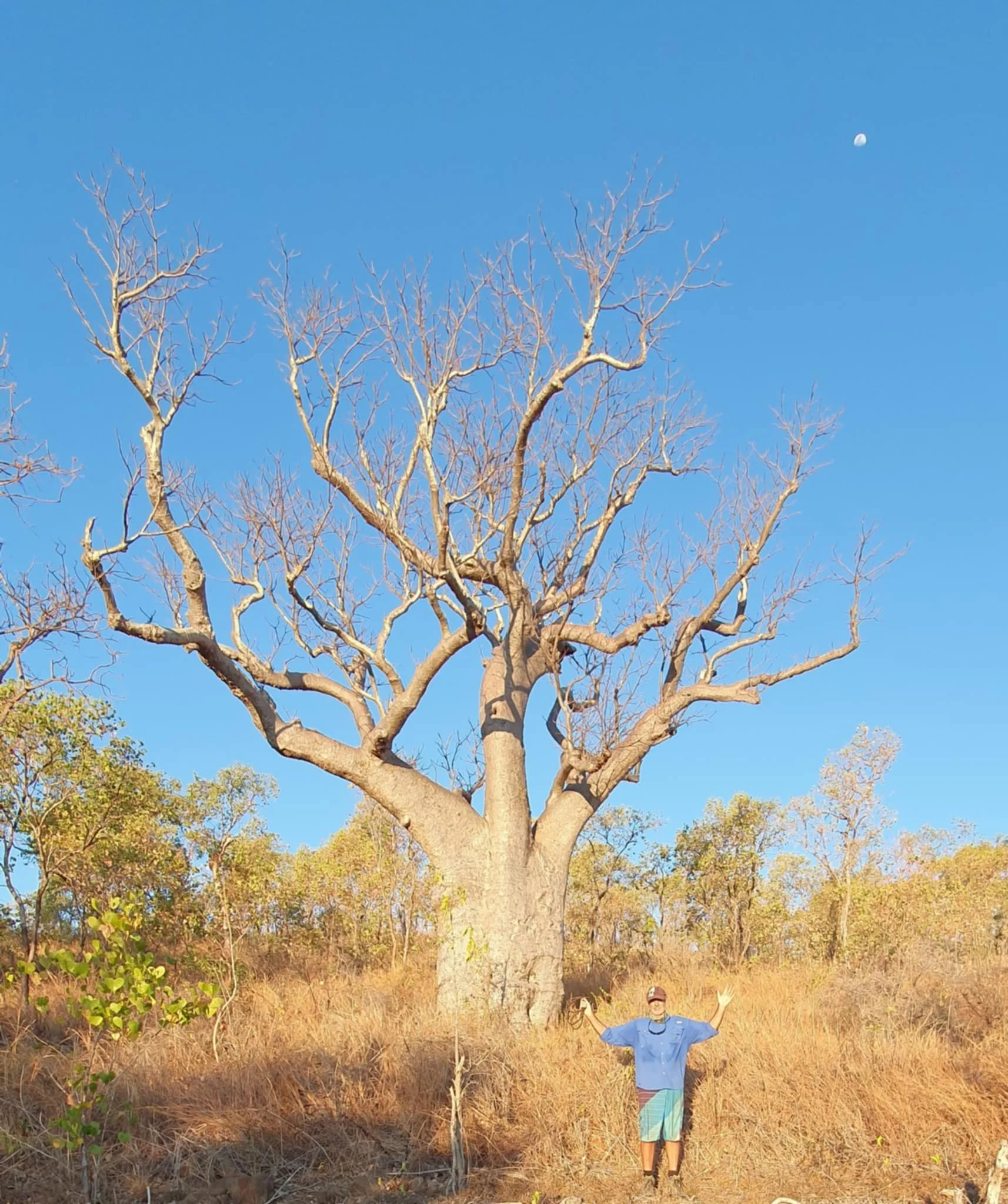
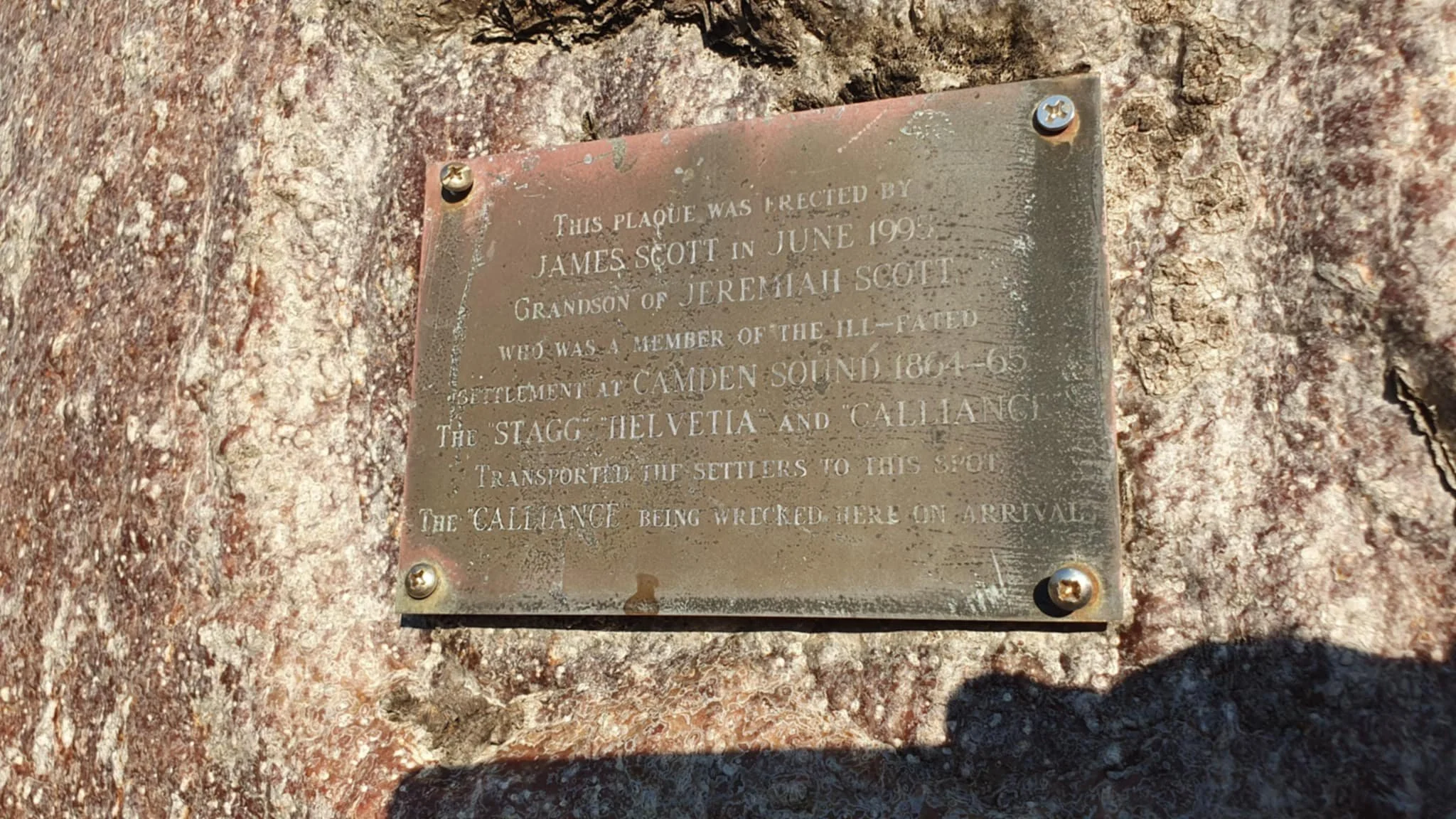
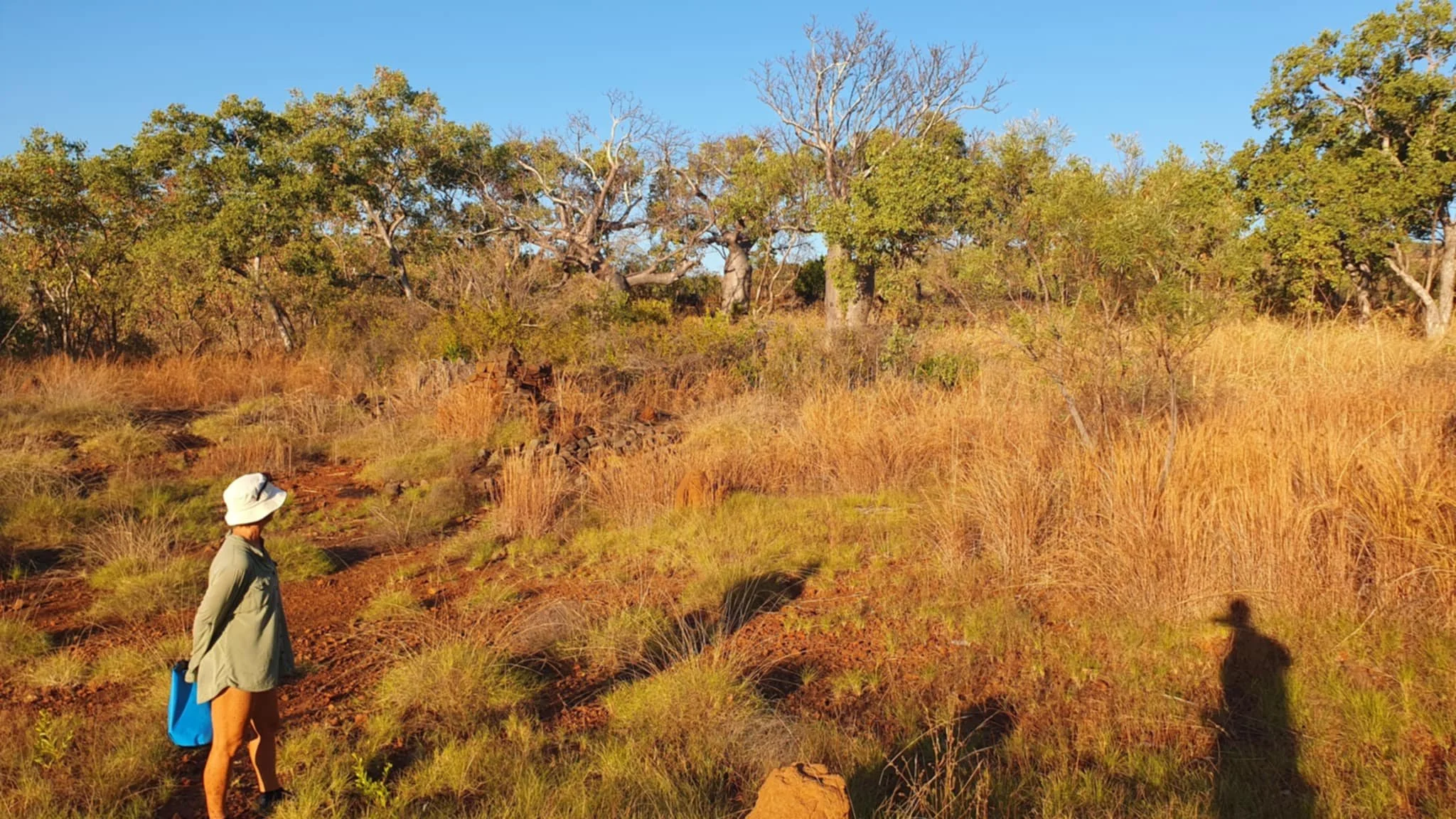




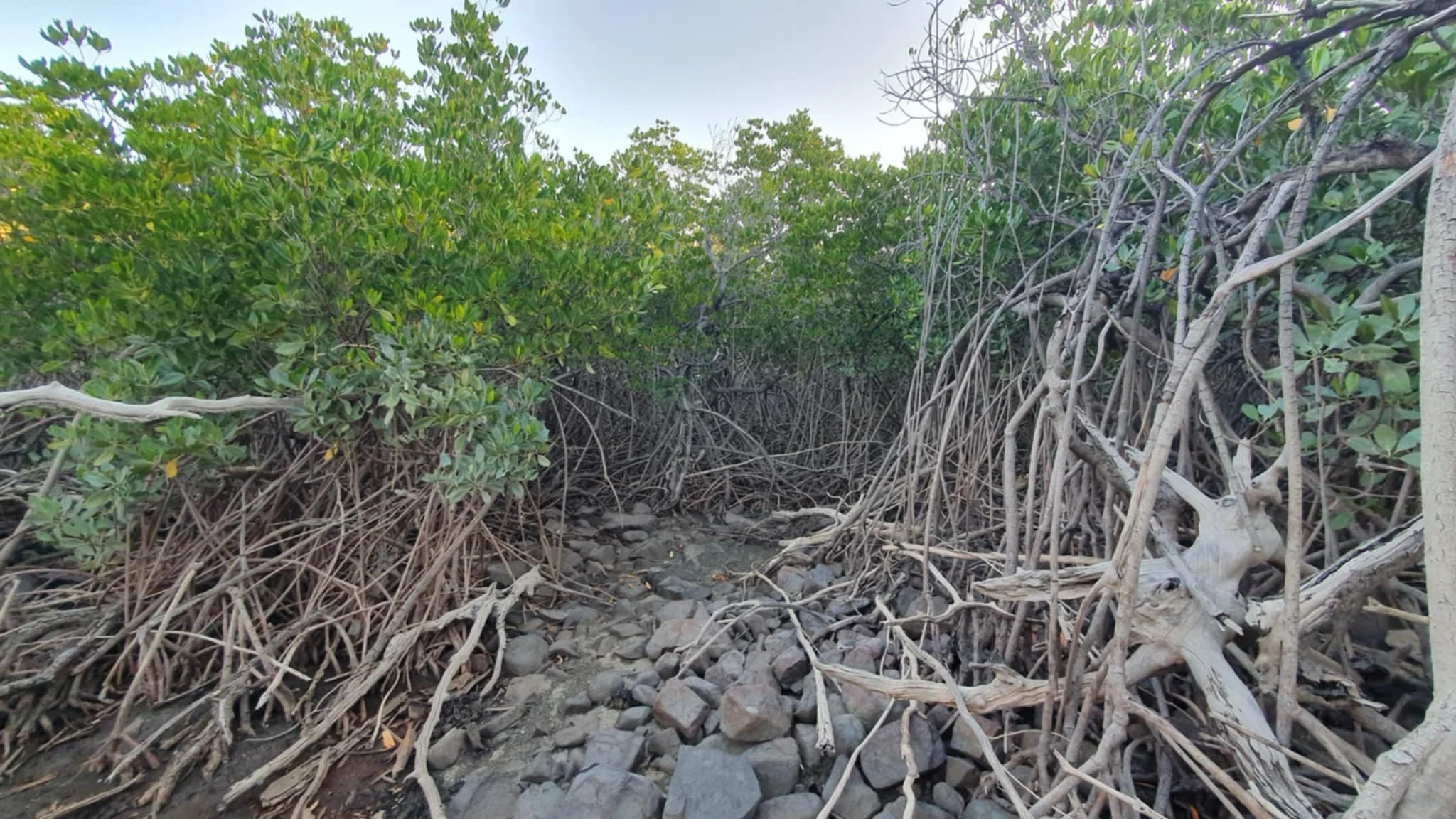




At one of the foundations, a small pile of crockery and other artifacts had been laid out, obviously found by other explorers like us and generously left for others to enjoy, giving an insight to what had been.
If you are interested some links here for more in this area:
Camden Harbour, Australia – Reflections on the attempted settlement of 1864-1865
One of the great things about the Kimberley is these pockets of history located throughout, the majority of which have been rarely visited and remain relatively untouched, giving you a real sense for what it must have been like in this beautiful but tough landscape.
The next morning, we departed northwards, via Rogers Strait, around into Goerge IV Sound, aptly named by Phillip Parker King and were treated to some more amazing scenery.
Next destination: Prince Regent River

